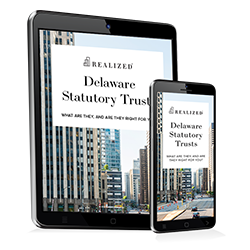The Realized Team’s Picks
Casualty or Condemnation at DST Level: Insurance Proceeds, Rebuilds, and Exchange Impacts

Are you considering investing in a Delaware Statutory Trust (DST)? This move is an appealing option for many investors, especially because of the passive income, steady cash flow, and capital gains tax deferrals. However, it’s important that you know certain events can add risk and complexity to the investment.
How Lender Reserves, Rent Credits, and Lease Abatements Are Reflected in Investor Reporting

When you receive reports from asset managers or sponsors in Delaware Statutory Trusts (DSTs), you may notice adjustments or line items that don’t immediately translate to cash in hand. Three items that warrant closer inspection are the lender reserves, rent credits, and lease abatements. What are these three adjustments, and how are they reflected in institutional real estate reports? Realized 1031 goes into the details to help you stay informed.
Tracking Basis Across Multiple DSTs After Several Exchanges (and Why It Matters)

When investing in Delaware Statutory Trusts (DSTs), it’s not unusual to then reinvest the proceeds into another, ensuring continued tax-deferral benefits and passive income. However, as each new investment begins, the complexity of tracking the DST basis becomes more and more intricate.
Multi-State DSTs: Withholding, Nonresident Returns, and Common Pitfalls

As you enter a Delaware Statutory Trust (DST), you begin earning money from the income-generating activities of the underlying properties. However, there is a chance that your DST holds assets across multiple states. This reality presents a few complexities, such as how state income tax is filed and paid.
DST K-1/1099 Packages: Reading the Footnotes Investors Actually Care About

As you’re likely aware, a Delaware Statutory Trust (DST) is a passive investment that provides passive income from the underlying real estate assets. When tax season comes, investors can expect forms like the K-1 or 1099—often thick and filled with numbers, codes, and footnotes.
Chaining Exchanges: Moving From One DST to Another Without Busting Your 1031

As you likely know, Delaware Statutory Trusts (DSTs) offer various advantages, like passive income and diversification. The fact that DSTs have holding periods, however, means a taxable event is always on the horizon. Thankfully, strategies like chaining exchanges are allowed, so you can move from one DST to another through 1031 exchanges, ensuring that you maintain your tax-deferral benefits.
Proceeds at DST Exit: Return of Capital vs. Gain and How This Shows Up on Your Tax Forms

At the end of a Delaware Statutory Trust (DST), the DST sponsor sells the assets and distributes the proceeds to the holders of beneficial interests. If you’re an investor, it’s crucial to know the difference between the original capital and gain from appreciation because of the different tax treatment and reporting requirements. Having this knowledge helps you prepare for your tax obligations and streamline your exit strategy after the full cycle event.
Rolling a DST Into an UPREIT via Section 721: Typical Holding Periods and Tax Trade-Offs

Investing in Delaware Statutory Trusts (DSTs) offers a range of benefits, like passive income and diversification. However, you may reach a point where you want to move beyond the advantages of just DSTs and gain access to larger real estate portfolios. One strategy you can use is rolling a DST into an umbrella partnership real estate investment trust (UPREIT).
Selling Fractional Interests: How Seasoned DST Interests Are Treated Off-Platform

Delaware Statutory Trusts (DSTs) are popular because of their passive nature, tax-deferral benefits, and opportunities for long-term cash flow. However, certain circumstances require you to liquidate your DST interests before the holding period is over. Whatever your reason, it’s important to understand how off-platform selling for fractional interest occurs, including the challenges and trade-offs you may encounter.
Exchanging Out of Self-Managed Rentals Into DSTs: Shifting From Active to Passive Without Breaking 1031

Owning and managing a rental property on your own can be challenging. From handling tenants to ensuring the property retains its value, there are lots of tasks and responsibilities that may lead to burnout. You may be considering letting go to ease the burden, but if the property has been acquired through a 1031 exchange, capital gains taxes will be triggered.


